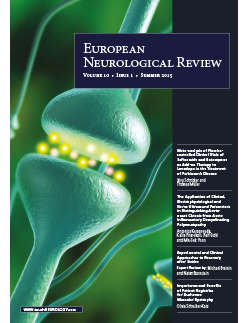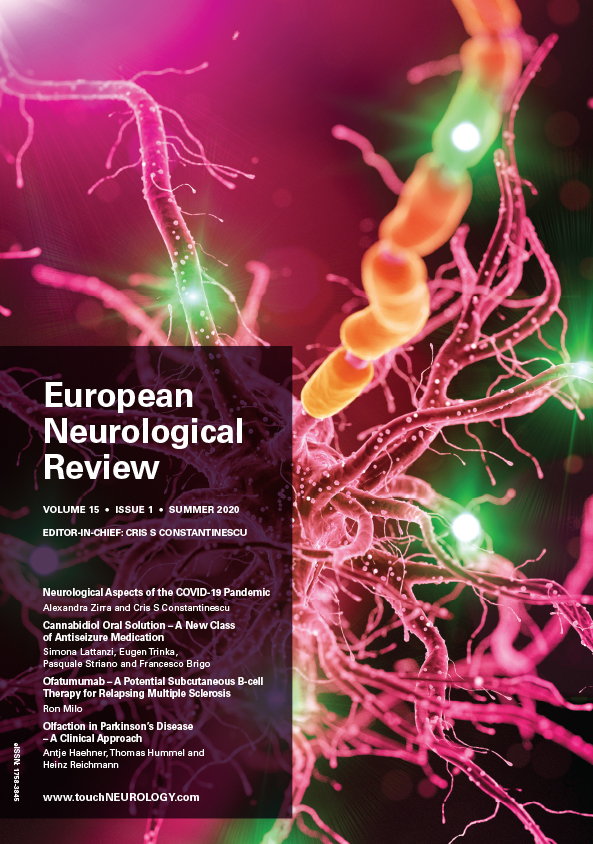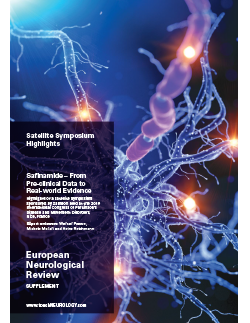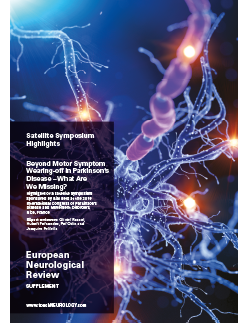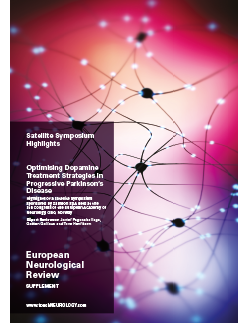EUROPEAN NEUROLOGICAL REVIEW – VOLUME 10 ISSUE 1 – SUMMER 2015
We are very pleased to present the summer edition of European Neurological Review. Editorial Board member Anna Sauerbier begins the edition with a special report on the European Academy of Neurology (EAN), of which she is a member of the Liaison committee and an active member of the European Association of Young Neurologists and Trainees (EAYNT). It is an exciting time for neurology in Europe, as we eagerly anticipate the first EAN congress, where free copies will be available to collect from the literature stand.
This edition features timely review articles and topical editorials, written by esteemed experts, succinctly examining a wide range of important topics including Parkinson’s disease, stroke, neuromuscular disorders, plus many more.
We hope you find this issue useful and that it provides helpful information and discussions that are relevant to your practice and interests. Please peruse and enjoy the expert content and we welcome any feedback you may have.
Welcome to the latest edition of European Neurological Review, which features a diverse range of articles covering a number of therapeutic areas. This edition begins with an article on multiple sclerosis (MS): Rogan presents a special report on the European Multiple Sclerosis Platform’s European Employment Pact for people with MS and other neurodegenerative conditions, launched […]
Special Report
The inauguration of the single and novel European Academy of Neurology (EAN) took place in Istanbul, Turkey, in June 2014 during the first and last Joint Congress of European Neurology, joining both the European Federation of Neurological Societies (EFNS) and European Neurological Society (ENS).1 The five main values of professionalism, high ethical standards, involvement, independence […]
Multiple Sclerosis
The European Employment Pact for people with multiple sclerosis (MS) offers a way forward in tackling the barriers and challenges faced by people with MS and other neurodegenerative conditions in the workplace. The Pact is mainly addressed to businesses, whether small and medium enterprises (SMEs) or multinational companies, which are prepared to recognise the value of […]
Movement Disorders
The signs and symptoms of Parkinson’s disease (PD), a chronic neurodegenerative disorder predominantly characterised by the loss of dopaminergic neurons in the substantia nigra pars compacta, are most effectively treated by levodopa (L-dopa). However, nearly all PD patients experience a fluctuating response to L-dopa sooner or later within the first 5 years of therapy dependent […]
Non-motor Symptoms in Parkinson’s Disease – Impact, Recognition and Management K Ray Chaudhuri Professor of Movement Disorders; Director, National Parkinson Foundation Centre of Excellence, Kings College, Denmark Hill Campus, London, UK Professor Chaudhuri considered that non-motor symptoms (NMS) were an integral part of Parkinson’s disease (PD) and the leading cause of poor quality of life […]
Introduction Maja Relja University Hospital Center Zagreb, Croatia Since its introduction in the 1980s, botulinum toxin type A (BoNT-A) has become the first-choice treatment for most types of focal dystonia, including cervical dystonia (CD) and blepharospasm. It is also widely used in the treatment of spasticity arising from stroke, spinal cord injury, multiple sclerosis and […]
First described by Willis in 1672 and described in more detail by Ekbom in 1945, restless legs syndrome (RLS) or Willis–Ekbom disease (WED) is defined as a sensorimotor disorder in which the initial sensory symptom consists of an irresistible urge to move the legs (or both the legs and the arms) and is accompanied by […]
Restless legs syndrome (RLS), or Willis–Ekbom disease (WED), is a sensorimotor disorder having well-known standardised diagnostic criteria1 that have been revised recently by the International Restless Legs Syndrome Study Group.2 The genetic basis of RLS has not been definitively established,3 but the most important biochemical findings are dopaminergic dysfunction and iron deficiency.4 The interest for […]
Traumatic Brain Injury
Traumatic brain injury (TBI) is a condition with many unmet needs in medicine and public health.1,2 It is a major cause of death and disability and also leads to extremely high direct and indirect costs to society.3–5 Currently the incidence of TBI among some populations such as the elderly and military personnel is increasing.6,7 TBI […]
Stroke
Stroke is one of the leading causes of death and disability in developed and less-developed countries.1,2 Effective therapeutic approaches to brain protection and recovery in stroke remain elusive, due to an incomplete understanding of the endogenous neurobiological processes involved in repair and a consequent inability to adequately stimulate them.3 Many trials of neuroprotective therapies for […]
Neuromuscular Disorders
Proceedings of a Symposium Presented at the 13th International Congress on Neuromuscular Diseases 2014 on 10 July in Nice, France Duchenne Muscular Dystrophy – Introduction Francesco Muntoni Duchenne muscular dystrophy (DMD) is a rare X-linked recessive disorder mutation in the DMD gene, Xp21. It is a progressive disease that is characterised by lack of dystrophin, […]
Duchenne muscular dystrophy (DMD) is the most common X-chromosomal inherited muscle disease in children. Nevertheless, having an estimated incidence of 1:5,000 male newborns, it is classified as a rare disorder.1 DMD results in progressive muscle weakness and severe disability, cardiopulmonary comorbidity and reduced life expectancy. Affected boys are limited in their independency, private and public […]
Guillain-Barré syndrome (GBS) is a rare but acute neuropathy occurring in 1.1–1.8/100,000 of the population (in Europe and North America).1 GBS manifests as limb weakness, areflexia and sensory loss proceeding to neuromuscular paralysis involving facial, bulbar and respiratory function. Symptoms reach a maximum severity in 2–4 weeks.2 The neuropathy frequently causes severe and lasting disability, […]
Chronic Inflammatory Demyelinating Polyneuropathy
Acute inflammatory demyelinating polyneuropathy (AIDP) is an acute monophasic polyradiculoneuritis whose incidence ranges from 0.89 to 1.89 cases (median, 1.11) per 100,000 person-years in Western countries.1,2 Chronic inflammatory demyelinating polyneuropathy (CIDP) is a common, albeit underdiagnosed and potentially treatable, disease having an estimated prevalence of 1.2–2.3 per 100,000.3 Although CIDP symptoms do not usually reach […]
Neurometabolic Disorders
Hunter syndrome (mucopolysaccharidosis II, OMIM 309900), is a rare progressive X-linked lysosomal storage disease caused by deleterious mutations in the iduronate-2-sulfatase (I2S) gene, leading to a deficiency of the enzyme.1,2 I2S is required for the catabolism of the glycosaminoglycans (GAGs) dermatan sulphate and heparan sulphate; in the absence of I2S, these GAGs accumulate in tissues […]
US Neurology Highlights
Monoclonal antibody (mAb) treatment has revolutionized the approach to many diseases and represents a fast-growing area of drug development.1,2 They are composed of immunoglobulin G (IgG) isotypes, divided into four subclasses.3 In 1986, the US Food and Drug Administration (FDA) approved muromonab-CD3, the first mouse-derived therapeutic mAb indicated for transplant rejection.4 Human or “fully human” […]
Multiple sclerosis (MS) is a chronic, progressive disease of the central nervous system, believed to be caused by an autoimmune process, and resulting in demyelination and axonal loss in the brain, spinal cord, and optic nerves. MS affects approximately 400,000 individuals in the US alone and 2.5 million people worldwide. A decline in neurologic function, […]
Demyelinating disorders of the central nervous system (CNS) occur in approximately 1/100,000 children. About one-fifth of these children will eventually receive a diagnosis of multiple sclerosis (MS).1 These cases constitute approximately 2–5 % of all cases of MS.2 Of these children, up to three-quarters will experience cognitive decline, depression, and/or fatigue, and irreversible motor disability […]

Trending Topic
Diabetic striatopathy (DS) is a rare hyperglycaemic condition associated with one or both of the following criteria: (1) acute-onset chorea–ballism (random, flowing and nonsuppressible involuntary movements) and (2) striatal hyperdensity on computed tomography (CT) scan or T1-weighted magnetic resonance imaging (MRI).1,2 DS is generally considered a complication of poorly controlled non-ketotic hyperglycaemia with acute hyperglycaemic surge, although […]
Journal Archive
European Neurological Review is a peer-reviewed, free-to-access, bi-annual neurology journal comprising review articles, case reports, practice guides, theoretical discussions, and original research. It features balanced and comprehensive articles written by leading authorities, addressing the most important and salient developments in the field of neurology in practical terms.
Latest articles videos and clinical updates - straight to your inbox
Log into your Touch Account
Earn and track your CME credits on the go, save articles for later, and follow the latest congress coverage.
Register now for FREE Access
Register for free to hear about the latest expert-led education, peer-reviewed articles, conference highlights, and innovative CME activities.
Sign up with an Email
Or use a Social Account.
This Functionality is for
Members Only
Explore the latest in medical education and stay current in your field. Create a free account to track your learning.


